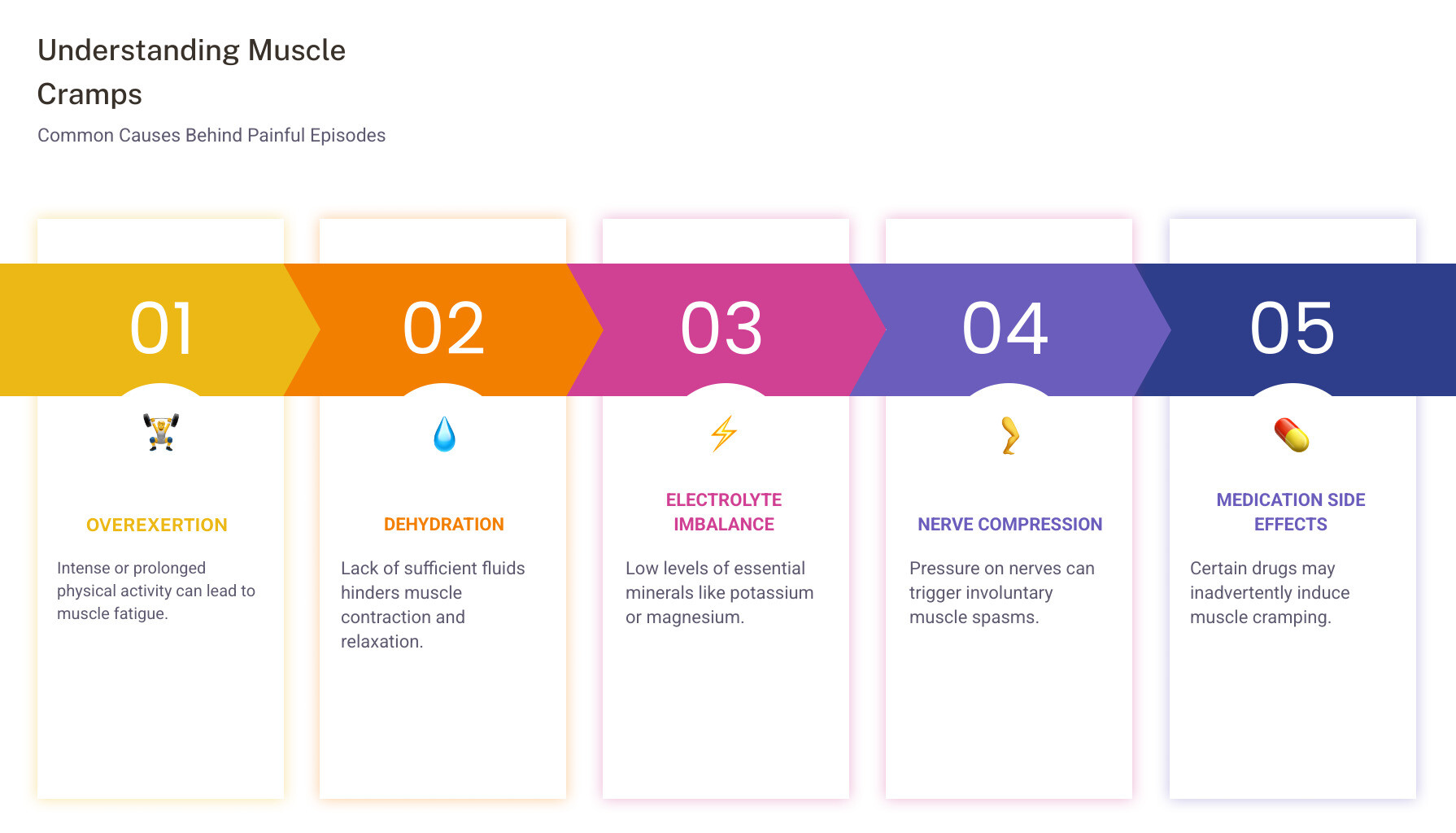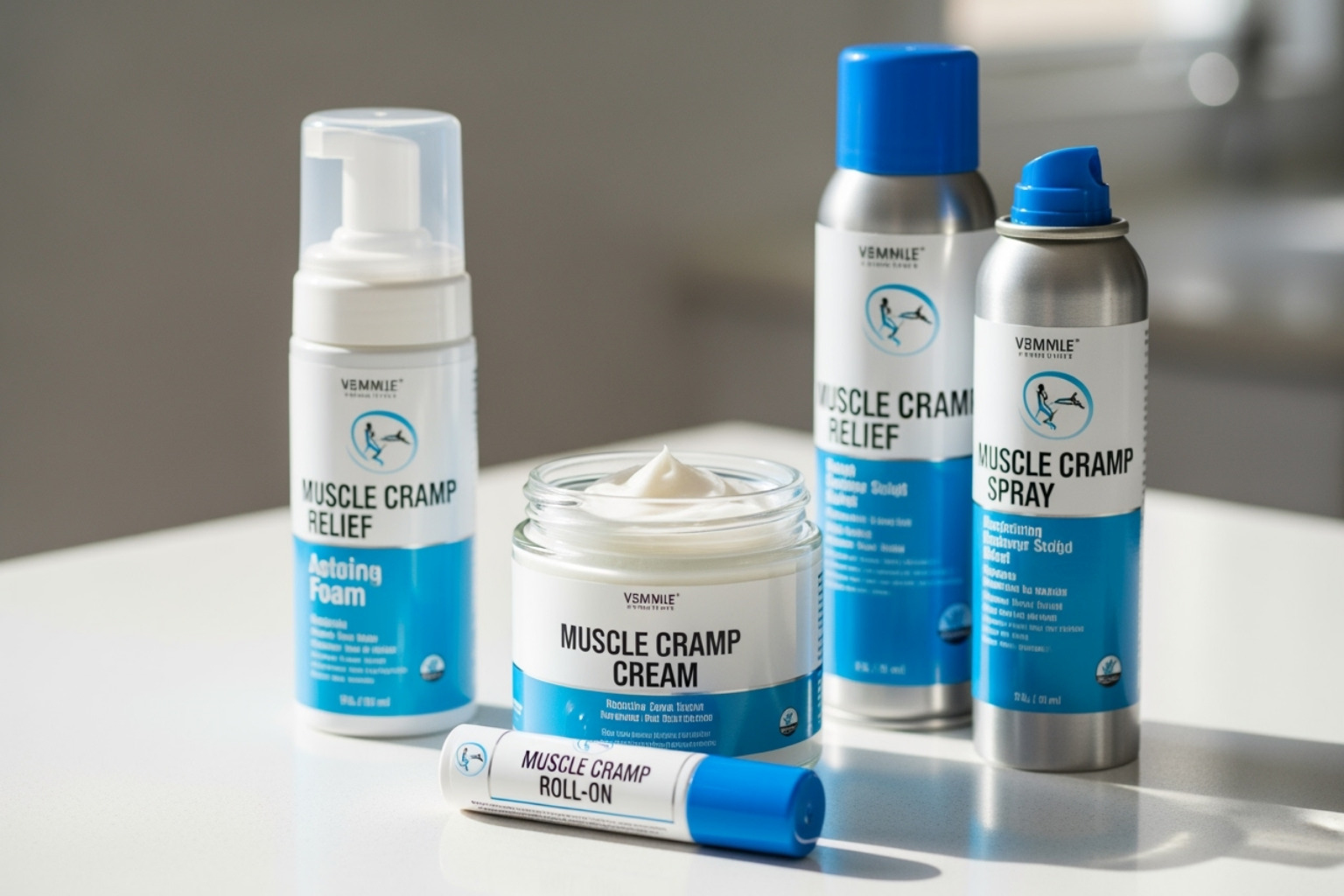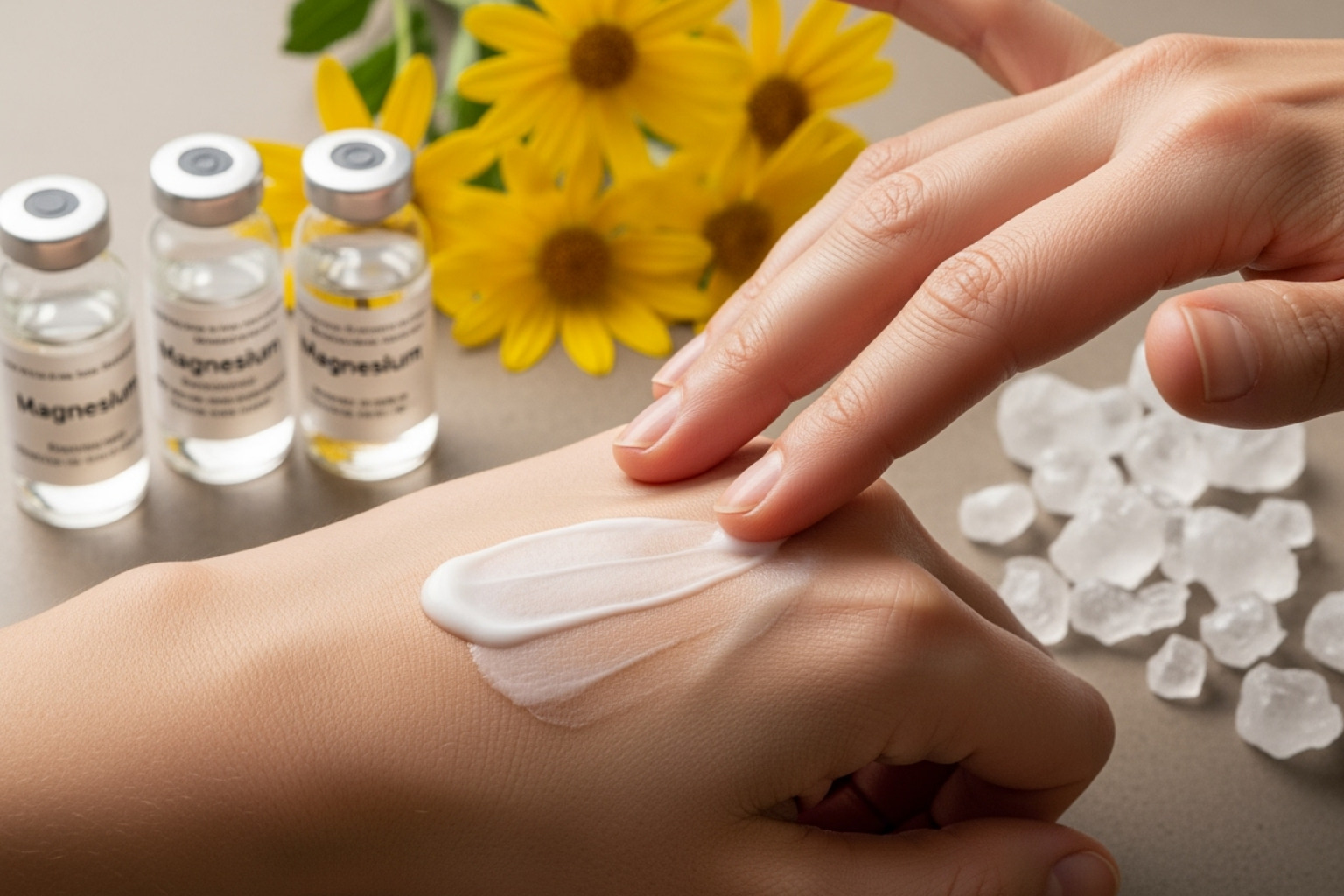When Muscle Cramps Strike: Understanding Your Relief Options
Muscle cramp cream offers fast-acting topical relief for the sudden, painful muscle contractions that can strike without warning. These over-the-counter solutions work by delivering active ingredients directly to the affected area, providing targeted relief from cramping, spasms, and post-cramp soreness.
Key Facts About Muscle Cramp Creams:
- Active ingredients often include magnesium, menthol, lidocaine, and homeopathic compounds.
- Application forms range from creams and foams to sprays and roll-ons.
- Relief time can vary from under a minute to several minutes, depending on the product.
- Duration may last up to 8 hours for some long-lasting formulas.
- Popular options are often recommended by pharmacists based on customer feedback and ingredient effectiveness.
Nothing should hold you back from living the life you want—whether it's a sudden charley horse during sleep or muscle spasms after exercise. As one satisfied customer shared: "I can rub it on and in no time cramps are gone, allowing me to get back to sleep."
Yet with dozens of products claiming miraculous results, understanding which muscle cramp cream actually works can be overwhelming. While some products show promise, others lack robust scientific evidence despite heavy marketing.
I'm Tony Enrico, and I've spent years researching natural pain relief solutions. My experience with muscle cramp cream formulations has shown me that the right combination of natural ingredients like menthol and aloe can provide genuine relief when you need it most.

Understanding Muscle Cramps: Why Do They Happen?
When your calf muscle suddenly twists into a painful knot in the middle of the night, you want relief fast. These unwelcome surprises are muscle cramps—sudden, involuntary contractions that can turn a peaceful moment into an ordeal.
A good muscle cramp cream can be your best friend in these moments, but understanding why cramps happen can help you prevent them.
Overexertion is a primary culprit. Pushing muscles beyond their comfort zone—whether in a new workout or a weekend sports game—can fatigue muscle fibers, increasing cramping risk. If you're dealing with post-exercise discomfort, our guide on What Helps Sore Muscles After Workout offers practical solutions.
Dehydration also plays a sneaky role. Muscles need adequate water to function smoothly. When you're low on fluids, especially during hot weather or intense activity, they become more prone to spasms.
This leads to electrolyte imbalances. Minerals like potassium, magnesium, calcium, and sodium are messengers that tell your muscles when to contract and relax. When these levels are off, communication breaks down. While a magnesium deficiency can cause cramping, research shows that oral magnesium supplements don't always resolve common muscle cramps in healthy adults.
Sometimes the problem isn't the muscle but nerve compression. Sleeping in an awkward position or having underlying spinal issues can pinch nerves, sending mixed signals that result in spasms. For more insights, check out our article on Muscle Aches.
Medication side effects can be a hidden cause. Diuretics, cholesterol medications, and certain asthma drugs sometimes list muscle cramps as a side effect. If you suspect your medication is the culprit, talk to your doctor.
More serious underlying health conditions like thyroid disorders, kidney disease, or diabetes can contribute to frequent cramping. Poor circulation also plays a role, as reduced blood flow deprives muscles of needed oxygen and nutrients.
Understanding these triggers helps you make better choices about prevention and treatment, including when to reach for that trusty muscle cramp cream and when to investigate the root cause.
The World of OTC Muscle Cramp Cream: What Are Your Options?

When a muscle cramp strikes, the pain relief aisle presents a wall of options. The good news is there's a muscle cramp cream for almost every preference. The challenge is knowing which one will help.
Most over-the-counter products fall into a few categories. Conventional analgesics rely on ingredients like menthol, camphor, or lidocaine. These work by creating warming or cooling sensations that distract your nervous system from the pain, or by numbing the area.
Homeopathic remedies take a different approach, using highly diluted natural substances like Arnica Montana or Magnesium Phosphorica. The theory is that these micro-doses stimulate your body's own healing response.
Then there are magnesium-based topicals, which feature magnesium sulfate as a key ingredient. The idea is to deliver magnesium directly through the skin, though scientific evidence for this method's effectiveness remains mixed.
Beyond the ingredients, the application method of your muscle cramp cream can make a real difference.
Creams vs. Foams
Traditional creams are thicker, more moisturizing, and perfect for massaging into tight muscles. The absorption rate is slower, but many find the hands-on massage therapeutic. Foams, on the other hand, are light, spread easily, and absorb quickly without a greasy feeling, making them ideal for covering larger areas fast.
Sprays vs. Roll-Ons
For no-mess application, sprays and roll-ons are excellent choices. Sprays deliver a fine mist that covers hard-to-reach spots quickly. Roll-ons combine convenience with precision. Their portability is a huge plus, and they are perfect for targeted relief on a specific knot or cramp. Whether you're dealing with general soreness or specific issues like Hip Muscle Pain, roll-ons let you pinpoint exactly where you need relief.
| Application Type | Pros | Cons | Best For |
|---|---|---|---|
| Creams | Deep massage, moisturizing, controlled application | Can be greasy, requires hand washing | Targeted relief, dry skin, muscle soreness |
| Foams | Quick absorption, non-greasy, spreads easily | Can be messy if not absorbed quickly | Larger areas, fast relief |
| Sprays | No-touch, quick application, good for hard-to-reach areas | Less control, can be inhaled, not for deep massage | Broad areas, quick relief, on-the-go |
| Roll-Ons | Targeted, mess-free, portable, light massage | Limited coverage, applicator can get dirty | Specific spots, travel, desk/nightstand use |
The best format often comes down to personal preference. A nighttime leg cramp might call for a soothing cream, while a sudden cramp during a workout might be better served by a quick-acting spray.
Decoding the Ingredients: How Do Muscle Cramp Creams Work?

When you're dealing with a muscle cramp, knowing what's in your muscle cramp cream can help you choose the right product. The secret lies in both the active ingredients doing the heavy lifting and the inactive ingredients that help deliver them.
Most creams work by creating cooling or warming sensations, delivering nutrients, or temporarily numbing the area. The challenge? Scientific evidence varies wildly between ingredients. Some have solid research backing, while others rely more on traditional use.
A Closer Look at Natural Ingredients
Natural and homeopathic ingredients have gained traction in the muscle cramp cream world, as many people prefer gentler approaches.
Magnesium Sulfate is a key ingredient in some popular topicals. Since magnesium is crucial for muscle function, the logic seems sound. However, while oral magnesium deficiency can cause cramps, the jury is still out on whether topical application helps most people with common muscle cramps.
Arnica Montana, a mountain flower, is a go-to homeopathic remedy for pain, stiffness, and soreness. It's believed to reduce inflammation and bruising, though the scientific mechanism isn't fully understood by conventional medicine.
Menthol is a key ingredient in our Neuropasil formulations. This cooling superstar stimulates cold receptors in your skin, creating an analgesic effect that distracts from pain. The cooling sensation provides immediate, comforting relief.
Aloe Vera is more than a supporting player. Its soothing properties keep skin hydrated and healthy, which is important when applying topical products regularly. At Neuropasil, we include Aloe to improve the overall comfort of using our cream.
How homeopathic ingredients are purported to work follows the principles of "like cures like" and "minimum dose." Substances are chosen because they might mimic cramp-like symptoms, then diluted to stimulate healing. The scientific community generally views these remedies as equivalent to placebos, though many users swear by their effectiveness.
If you're dealing with nerve-related discomfort, our guide on Nerve Pain Relief with Neuropasil Natural Solutions can be helpful.
Conventional Ingredients and Their Evidence
Conventional muscle cramp cream ingredients often have clearer mechanisms of action.
Trolamine Salicylate, a relative of aspirin, is designed for topical pain relief. However, studies on its effectiveness show mixed results from studies, with older research not providing strong support for its claims.
Lidocaine is a topical anesthetic that blocks nerve signals carrying pain messages to your brain. It has solid scientific backing for localized pain relief, particularly for irritated nerves that can contribute to muscle discomfort and conditions like Sciatic Nerve Pain.
Diclofenac is a topical nonsteroidal anti-inflammatory drug (NSAID) primarily designed for arthritis, but its ability to reduce inflammation can help with muscle-related discomfort.
A reality check comes from sources like Harvard Health, which notes that many heavily advertised remedies often lack the peer-reviewed studies to support their bold claims. The lack of robust evidence for topical magnesium for common muscle cramps is a prime example. This doesn't mean these products don't work for individuals, but it highlights that the best evidence is often your own experience.
Choosing the Right Product: A Buyer's Guide
Walking down the pharmacy aisle, staring at dozens of muscle cramp cream options, can feel overwhelming. How do you separate marketing hype from genuine relief? The best choice comes from combining expert opinions, real user experiences, and a careful look at what's in the bottle.

Start with the experts. Pharmacists see which products and ingredients customers find effective. They can recommend options based on real-world results they witness daily, guiding you toward a type of product that might work for you.
Listen to real customers. While marketing claims sound impressive, nothing beats hearing from someone who's used a product at 2 AM for a calf cramp. Look for products with thousands of reviews and high average ratings. Read both positive and negative comments to get a realistic picture. Honest reviews often reveal potential downsides, like value for money or texture inconsistencies.
Read those labels carefully. The FDA doesn't directly evaluate the safety and effectiveness of all over-the-counter products the same way it does prescription drugs. This means you need to be your own detective. Look for active ingredients that make sense for your needs—menthol for cooling relief, lidocaine for numbing, or natural options like arnica.
Know the warning signs. Every reputable muscle cramp cream will list precautions. Watch for the basics: external use only, avoid contact with eyes, don't apply to broken skin, and stop if irritation develops. If you're pregnant, nursing, or taking medications, always check with your healthcare provider first. Also, never use heating pads or ice packs with certain topical analgesics unless your doctor approves.
Consider the practical stuff. The best cream won't help if you hate using it. Decide if you prefer a cooling menthol sensation or something neutral. Fragrance-free options are great for sensitive skin, and non-greasy formulas are essential if you need to get dressed quickly.
When evaluating any muscle cramp cream, ask yourself: Does this solve my specific problem? If you're dealing with general muscle soreness after workouts, our guide on What Helps Sore Muscles might offer additional insights. Finding your ideal product may take some trial and error, but by combining expert advice, user feedback, and careful label reading, you're more likely to find relief.
Beyond the Cream: A Holistic Approach to Cramp Prevention
While muscle cramp cream is a lifesaver when a cramp strikes, preventing them in the first place is even better. The most effective approach combines smart prevention with good topical relief when needed.

The foundation of cramp prevention starts with staying properly hydrated. Many people find their cramps lessen once they start drinking water consistently throughout the day. Your muscles need that fluid balance to function smoothly.
Your diet plays a starring role, too. Eat foods rich in potassium like bananas and spinach, and magnesium from leafy greens, nuts, and seeds. While topical magnesium has mixed results, getting enough through your diet is definitely worthwhile. Sodium matters too, especially if you sweat a lot. Electrolyte drinks can help prevent exercise-related cramping.
Regular stretching is one of your best defenses. A few minutes of gentle calf and hamstring stretches before bed can make a huge difference for nighttime cramps. When a cramp hits, gently stretching the muscle often provides immediate relief. For more recovery strategies, see our guide on how to Reduce Muscle Soreness After Workout.
Self-massage can also improve blood flow and release tight spots before they become full-blown cramps. Using a warming cream during your massage can improve the relaxation effect.
Heat therapy, like a warm bath or heating pad, helps muscles release tension. The increased blood flow delivers nutrients and removes waste products that contribute to cramping.
If you get foot cramps, check your proper footwear. Supportive shoes can prevent the muscle fatigue that leads to cramping.
Finally, if you're starting a new exercise routine, ease into it. Your muscles need time to adapt. Pushing too hard too fast is an invitation for cramps.
This holistic approach works hand-in-hand with quality topical relief. Combining smart prevention with a good muscle cramp cream for breakthrough cramps gives you the best chance at staying comfortable and active.
Frequently Asked Questions about Muscle Cramp Creams
I get many questions about muscle cramp cream from people dealing with sudden cramps or persistent muscle discomfort. Here are the most common concerns and what I've learned from research and customer feedback.
How quickly do muscle cramp creams work?
The speed of relief depends on the ingredients and your body's response. Some products with fast-acting ingredients like menthol or lidocaine can provide relief in 30 to 60 seconds. Users often report that they can apply a cream during a nighttime cramp and get back to sleep quickly.
However, not all creams work the same way. Some offer immediate release from spasms, while others are better at soothing post-cramp soreness. The menthol in our Neuropasil formulas, for instance, creates a cooling sensation that can distract from pain very quickly.
My advice is to check product claims and read customer reviews to get a realistic idea of timing. What works in 30 seconds for one person might take a few minutes for another.
Can I use these creams for other types of pain?
This is a great question, as muscle cramps often accompany other issues like joint aches or nerve irritation. Some products are multi-purpose, but you should always check labels for intended use.
Products with lidocaine are effective for numbing aggravated nerves. If you're dealing with sciatica or other nerve issues, specialized formulations for arthritis pain or nerve pain might be more targeted than a general muscle rub.
At Neuropasil, we've designed our creams to work across multiple pain types. Customers use them for everything from muscle cramps and neuropathy to joint discomfort, making it a versatile muscle and nerve pain relief cream.
Are homeopathic muscle cramp creams effective and safe?
This question always sparks debate. Homeopathic muscle cramp cream products use extremely diluted ingredients, so diluted that often no original molecules remain.
The conventional medical view is skeptical. The Harvard Health Ad Watch questions claims made by many such remedies, citing a lack of robust, independent studies. Many scientists believe any benefits come from the placebo effect.
Despite this, some people swear by these products. If a person feels better and the product is safe, that experience is valid for them.
Regarding safety, homeopathic creams are generally considered safe for topical use on intact skin due to the extreme dilutions. The risk of adverse reactions from the active ingredients is very low. However, any cream can cause skin irritation, so always do a small patch test first.
If you're pregnant, breastfeeding, or have other health concerns, consult a doctor before trying any new product, even a homeopathic one.
Conclusion
Finding the right muscle cramp cream doesn't have to be a puzzle. By understanding the causes of your cramps and the ingredients designed to treat them, you can make an informed choice.
We've seen that the "why" behind cramps—be it dehydration, overexertion, or an electrolyte imbalance—gives us the power to address them. We've also learned that topical relief comes in many forms, from traditional creams and quick-absorbing foams to no-mess sprays and roll-ons.
Ingredient awareness is your most valuable tool. While menthol provides immediate cooling distraction and lidocaine offers targeted numbing, other ingredients have less scientific backing. The smart approach combines expert advice with real customer experiences and a close reading of the product label.
Perhaps most importantly, the best defense against muscle cramps is prevention. Staying hydrated, eating a balanced diet, stretching regularly, and listening to your body can stop many cramps before they start.
At Neuropasil, we developed our muscle pain relief cream with this holistic understanding. Our natural formula combines the cooling relief of menthol with the soothing properties of aloe, improved with urea for deeper penetration. We've heard from customers dealing with everything from nighttime leg cramps to post-workout tension who have found genuine relief with our targeted approach.
The beauty of our natural ingredients lies in their effectiveness and gentleness. Our loyal customers appreciate having a fast-acting solution for neuropathy, sciatica, or simple muscle fatigue. It's a versatile cream for both muscle and nerve pain.
Your journey to cramp-free living includes understanding your body, maintaining good habits, and having reliable relief when you need it most. For a comprehensive look at managing all types of muscle discomfort, explore our guide on the best products for muscle pain.
Because at the end of the day, nothing should keep you from living the active, comfortable life you deserve—not when effective, natural relief is within reach.













